Questyle CMA Fifteen miniHype
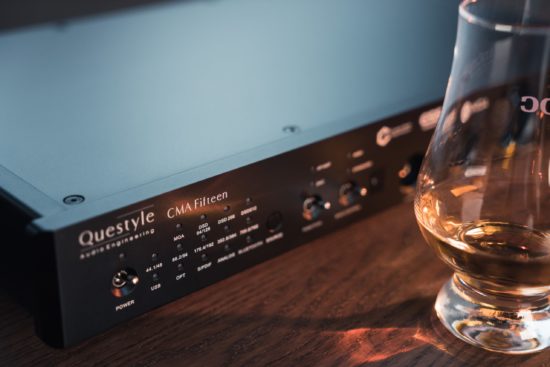
The CMA Fifteen offers multiple connectivity options (such as optical, USB and Bluetooth), a ‘bias’ selection and a choice of gain suitable for both in-ear monitors and the most-demanding over-ear headphones. However, it offers no frills and no unnecessary clutter when it comes to audio adjustments (it lacks any built-in EQ or bass/mid/treble adjustment and there is no choice of anti-aliasing filter).
The sound of the CMA Fifteen reminds us of the Gold DAC/amp stack, but at a much more reasonable price point (the Gold DAC/amp stack retailed for upwards of ten thousand US dollars). The CMA Fifteen definitely has characteristic Questyle acoustics, rather similar to that of the portable QPM DAP, which is clearly seen in its measurements.
Most of our tests were performed via the optical input, driven by devices such as the QP2R or Astell & Kern SP2000. We found the sound of the CMA Fifteen via optical output to be good, but we were less impressed with the Bluetooth connection when coupled with an iPhone XS. In fairness, we should note that other (e.g., Android) devices are capable of supporting better codecs than current iPhones, however the sound of the Bluetooth-sourced connection compared to the optical connection was night and day, and we would expect most people would use the CMA Fifteen via a wired (USB) or TOSLINK connection. (All of our measurements used the latter.) The versatility of this device is certainly appreciated, but we feel that if you are going to purchase and use a desktop DAC/amp such as the CMA Fifteen, you will certainly want to experience it with an optical connection for the best possible acoustics.
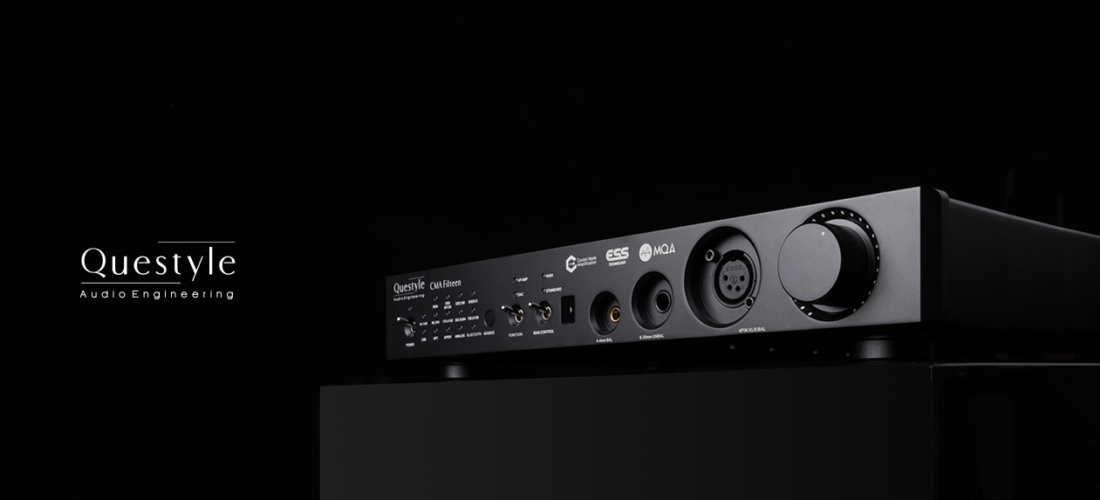
We noted some minor channel imbalance when adjusting gain via the volume potentiometer at low SPLs, suggesting this device is perhaps best not used with sensitive in-ear monitors (where moving the volume pot just a few degrees will blow out your eardrums, even on low gain).
Our measurements of the CMA Fifteen show a fairly average performance – good enough that most end users shouldn’t need to be particularly worried, but certainly not as good as we would have expected from a flagship ESS DAC. Firstly, we can see that the gain settings have no impact on audio quality:
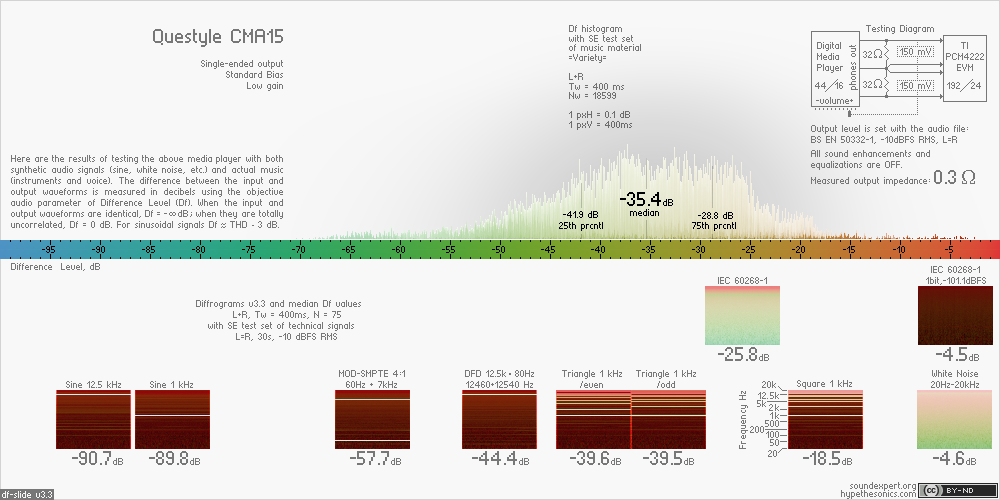

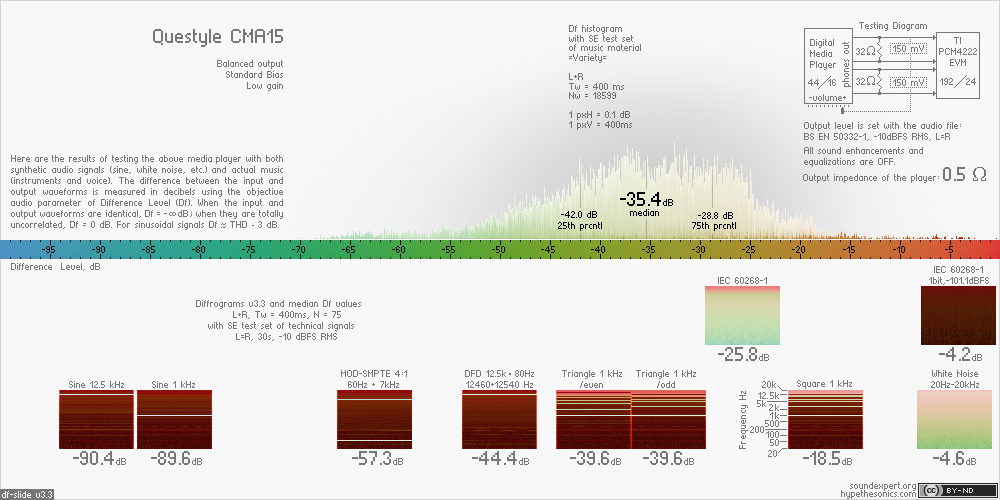
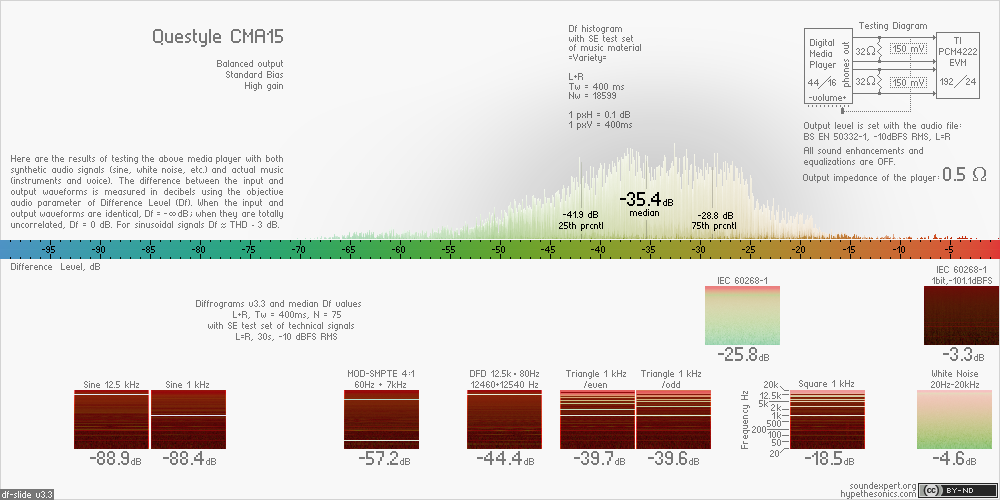
This effect, or lack thereof, with respect to gain is perhaps to be expected. Some audio enthusiasts continue to believe that balanced outputs bring improved audio quality, but we have never seen that in measurements. The CMA Fifteen confirms what we’ve seen in pretty much every other device – that balanced output to a short-cable-connected headphone buys very little of any significance, beyond (perhaps, in some devices) extra output power. Channel separation can improve with a balanced output, but is almost never an issue to begin with in single-ended outputs from modern DACs. Balanced outputs mainly just increase output impedance, and the CMA Fifteen shows the typical pattern of Z-out doubling on its balanced output. Curiously, we also heard no difference as a result of toggling the CMA Fifteen’s bias switch. As with our earlier QPM measurements, we see no difference at all in measurements with low vs high bias. Our research indicates that such near-identical measurements mean no human would tell these signals apart, so it would seem the bias switch (at least on the unit we tested) has no purpose beyond placebo:


The ES9038PRO DAC is a top-of-the-line component from what appears to be (as of 2022) the manufacturer of the world’s most accurate DAC chips. We expected somewhat better accuracy than this, given our past experience with ESS DACs. (The above measurements can be compared with those from our DAP database.) There may be something going on with Questyle’s current mode amplification or implementation that causes some (possibly intentional?) shaping of the sound. If so, we’d generally object to such tweaks, because any such preferences are inevitably subjective, can’t be widely applicable to all types of recordings of all music genres and all hearing preferences. Unfortunately, it seems that very few manufacturers optimize their devices for accuracy. We should note that our main error metric here – the df (histogram) median is a relatively new metric and still the subject of ongoing research. However, it is typically revealing of problems reproducing more complex waveforms, such as actual music tracks.
One benefit of the CMA Fifteen (and indeed of all Questyle devices) is the impressively-low output impedance. The importance of this shouldn’t be underestimated – this can sometimes be a more important metric than the df-median error, as high output impedance has the ability to significantly alter the basic frequency response of certain headphones.
The CMA Fifteen is a fantastically versatile Swiss-army knife of a DAC/Amp, capable of driving pretty much anything, from pretty much any source, however it won’t be worth the hype for everybody. Its reproduction accuracy doesn’t exceed that of other (cheaper) devices on our database, but it does have a lot more versatility in terms of usage, with a lot more power output power than most portable devices.
—————————————————
Did You Know?
All products on our databases come with a ‘microHype’ – brief subjective thoughts and impressions on the product and its ranking. To access the DAP microHypes, simply click on the slide for that DAP. To access the microHype for a headphone, click on the name of the heaphone once displayed, or click on the (red) score in any rank/search result. Certain products that are regarded as special, or particularly relevant or interesting, have more extensive reviews in the form of ‘miniHypes’. The latest miniHype is always displayed on HypetheSonic’s front page, with archived miniHypes shown below.
